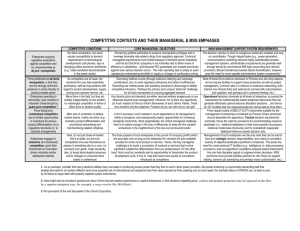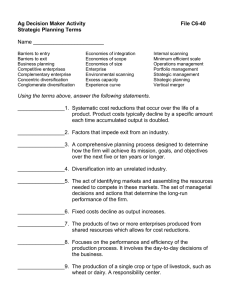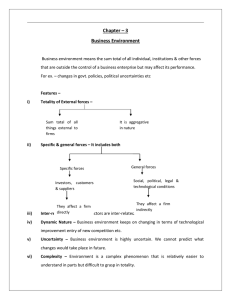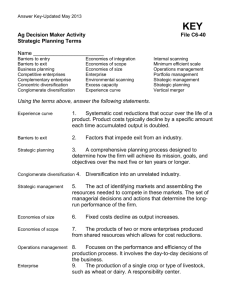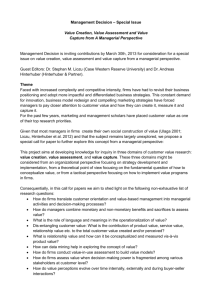1 - Information Systems
advertisement
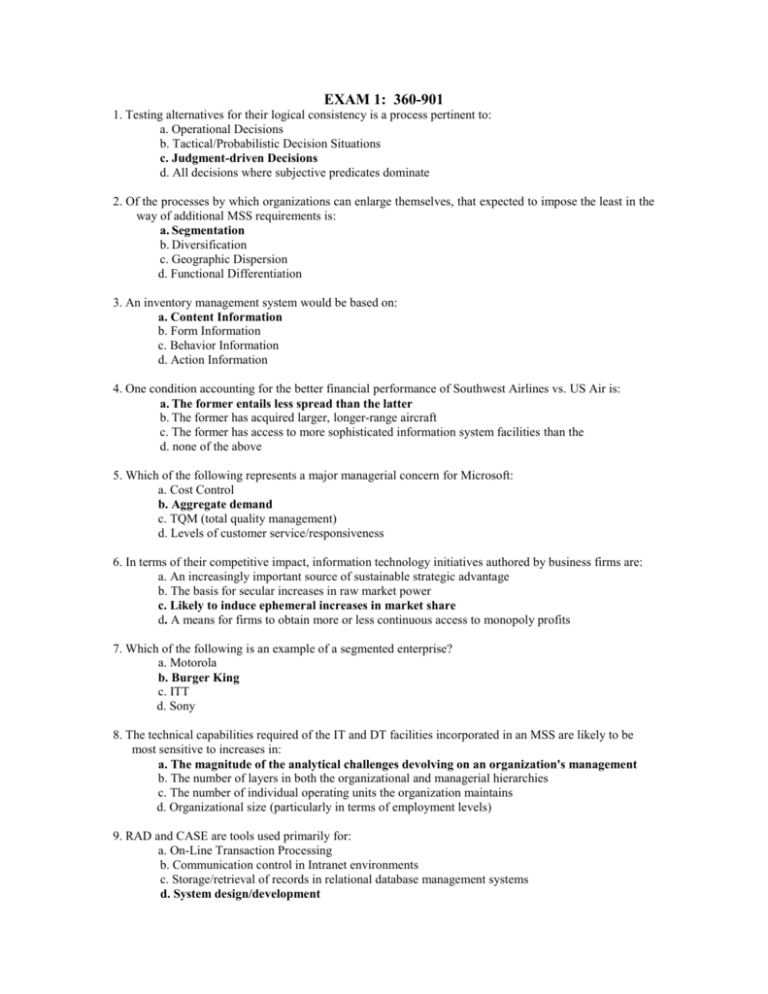
EXAM 1: 360-901 1. Testing alternatives for their logical consistency is a process pertinent to: a. Operational Decisions b. Tactical/Probabilistic Decision Situations c. Judgment-driven Decisions d. All decisions where subjective predicates dominate 2. Of the processes by which organizations can enlarge themselves, that expected to impose the least in the way of additional MSS requirements is: a. Segmentation b. Diversification c. Geographic Dispersion d. Functional Differentiation 3. An inventory management system would be based on: a. Content Information b. Form Information c. Behavior Information d. Action Information 4. One condition accounting for the better financial performance of Southwest Airlines vs. US Air is: a. The former entails less spread than the latter b. The former has acquired larger, longer-range aircraft c. The former has access to more sophisticated information system facilities than the d. none of the above 5. Which of the following represents a major managerial concern for Microsoft: a. Cost Control b. Aggregate demand c. TQM (total quality management) d. Levels of customer service/responsiveness 6. In terms of their competitive impact, information technology initiatives authored by business firms are: a. An increasingly important source of sustainable strategic advantage b. The basis for secular increases in raw market power c. Likely to induce ephemeral increases in market share d. A means for firms to obtain more or less continuous access to monopoly profits 7. Which of the following is an example of a segmented enterprise? a. Motorola b. Burger King c. ITT d. Sony 8. The technical capabilities required of the IT and DT facilities incorporated in an MSS are likely to be most sensitive to increases in: a. The magnitude of the analytical challenges devolving on an organization's management b. The number of layers in both the organizational and managerial hierarchies c. The number of individual operating units the organization maintains d. Organizational size (particularly in terms of employment levels) 9. RAD and CASE are tools used primarily for: a. On-Line Transaction Processing b. Communication control in Intranet environments c. Storage/retrieval of records in relational database management systems d. System design/development 10. A simulation system would deliver which of the following classes of information? a. Content b. Form c. Behavioral d. Action 11. One common tactic for determining system requirements is: a. OLN Bi-Assessment b. Benchmarking c. Syncretics (in its collective variant) d. all the above 12. Which of the following would be thought to provide empirical data: a. A medical biopsy b. Eyewitness accounts of accidents c. Movie reviews from major news services d. all the above 13. Given the limitations on the effective reach of modern management support technology, unmanageability is most likely to be caused by increases in organizational complexity via: a. Concentric diversification b. Eccentric diversification c. Decreases in spread d. Increases in size and/or volume of activities 14. What is a key mission(s) for management support systems serving firms operating under conditions of constrained competition: a. Provide early-warning of major product innovations planned by competitors b. Provision of data to drive cost-accounting calculations c. Enforce an organization-wide commitment to total quality management (TQM) d. all the above 15. A firm particularly notable for the sophistication of it IT-based inventory management systems is: a. General Motors b. H&R Block c. Wal-Mart d. World-Com 16. The first and continuingly most successful transition to just-in-time production was based on: a. General Motors Rapid Response process b. The Need-it-Now system inaugurated by Boeing c. The kanban concept as implemented by Toyota 17. Which of these classes of enterprises is likely to have the most intense need for information system facilities that can capture and distill clinical data: a. Monopolies (both de jure and de facto) b. Firms operating in primary industries c. Enterprises engaged in regulated competition d. Innovation-dependent enterprises 18. What the authors of the Virtual Corporation refer to as channel information is also comprehensible as: : a. Primary data b. Secondary data c. Indicators d. Intelligence items 19. The SABRE system is best appreciated as: a. An innovation that provided information bases of greater currency b. A technology that provided United Airlines with an early edge over its competitors c. A system that resulted in a reduction of control for both travel agents and consumers 20. Of the following, which is an instance of secondary data? a. Blood counts b. Census reports c. Inventory counts via RFID d. Electronic emissions intercepts 21. Which of the following is a characteristic of modern MSS constructs? a. Decision predicates are delivered as directly as possible to senior managerial functionaries b. Information system requirements are determined independent of decision requirements c. Decision technology stands in service to information technology d. none of the above [DATA GOES TO DECISION MODELS!] 22. Which of the following is true of clinical predicates: a. They are generally the easiest and least costly to obtain b. They provide the highest level of discriminacy c. The are the underpinnings for a posteriori propositions d. all the above 23. As a general rule, the business enterprises that rely most heavily on advertising are most likely to be operating in contexts (industries, markets) characterized by: a. Quasi-pure competition b. Constrained competition c. Extensive Competition d. Post-oligopolistic competition 24. The key distinctions between the conventional management theory and technical perspectives on managerial decision making is that: a. Not all enterprises have a need for operational decision support facilities b. Not all tactical decision situations demand probabilistic decision aids c. Not all higher managers have strategic decision responsibilities d. none of the above 25. Information from focus groups is of which of these types: a. Clinical b. Empirical c. Indicative d. Interpretive
